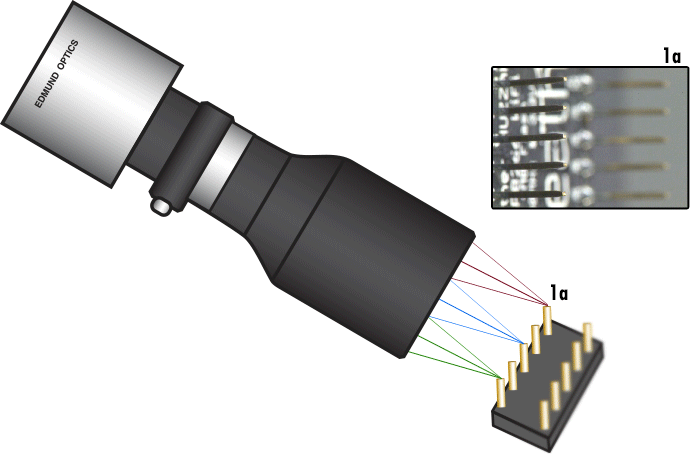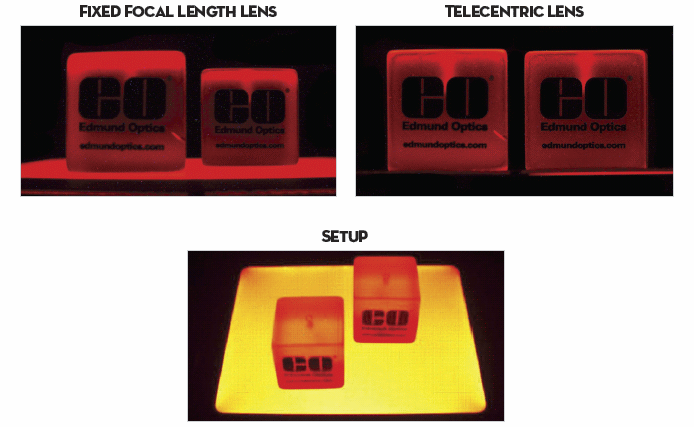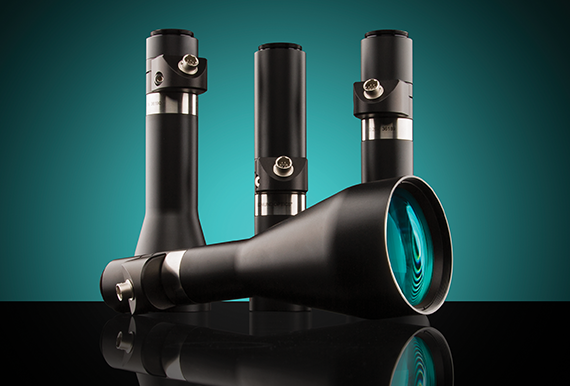
|
|
Liquid lens integrated into telecentric lens for quick autofocus |
|
|
Eliminate parallax error while changing working distance |
|
|
Telecentricity maintained across entire working distance range |
|
|
Ideal for gauging, measurement, and placement applications |
Liquid Lens Telecentric Lenses provide fast, accurate, and precise measurements and help speed up the throughput of inspection systems. Conventional telecentric lenses have a fixed working distance and cannot compensate for objects at different working distances. In order to inspect objects with depth using a conventional telecentric lens, the object would need to be repositioned or a new telecentric with a different working distance would need to be used. This constraint leads to delays in measurement and limits throughput. On the other hand, Liquid Lens Telecentric Lenses overcome these speed limitations by quickly refocusing to different working distances in a matter of milliseconds.
A conventional imaging lens requires mechanical refocusing for objects of different sizes, causing a delay that limits throughput. The animation below (Figure 1) shows how a Liquid Lens Telecentric Lens can be utilized in the inspection of circuit boards to quickly adjust working distance and refocus on different pins.

The angular field of view of conventional lenses leads to a decrease in magnification as the distance between the object and the lens increases, resulting in parallax, or perspective error. This decreases accuracy, as the magnification change will make the observed measurement of the imaging system change if the object is moved, even when staying within the depth of field of the lens. Telecentric lenses eliminate parallax error by having a constant, non-angular field of view, and therefore have no change in magnification with respect to depth. This is illustrated in Figure 2, which compares images of two different objects at different working distances using both a telecentric lens and a conventional fixed focal length lens.

However, telecentric lenses are optimized for a specific working distance. Integrating a liquid lens allows a lens to compensate for changing working distances even further, while maintaining telecentricity and image quality across the whole working distance range.
To learn more about telecentricity, read our application note on the Advantages of Telecentricity.
Liquid lenses are small cells containing optical-grade liquid. This liquid can change shape when a current or voltage is applied to the liquid lens cell, causing the focal length and working distance of the lens to shift. Liquid lenses are an ideal solution for imaging applications dependent on quick refocusing, high throughput, and accommodation for changing working distances.


The TECHSPEC® MercuryTL™ Liquid Lens Telecentric Lenses from Edmund Optics® contain an integrated liquid lens for quick autofocus while maintaining telecentricity throughout the entire working distance range. They are an ideal combination of the proven performance of our TECHSPEC® telecentric lenses with the flexibility of a liquid lens.
LEARN MORE What primary magnifications are available for the TECHSPEC® MercuryTL™ Liquid Lens Telecentric Lenses from Edmund Optics®?
What primary magnifications are available for the TECHSPEC® MercuryTL™ Liquid Lens Telecentric Lenses from Edmund Optics®?
 Can Edmund Optics® make customized Liquid Lens Telecentric Lenses?
Can Edmund Optics® make customized Liquid Lens Telecentric Lenses?
Yes, we can make customized Liquid Lens Telecentric Lenses tailored to your specific application. For more information, please contact our application support engineers.
 Can I integrate a liquid lens into another type of lens, such as a fixed focal length lens?
Can I integrate a liquid lens into another type of lens, such as a fixed focal length lens?
Yes, we can integrate liquid lenses into other types of lenses as a custom request. We also offer the modular Cx Series Fixed Focal Length Lenses, in which you can integrate interchangeable accessories including liquid lenses, fixed apertures, and internal filter holders.
 How do I mount a TECHSPEC® MercuryTL™ Liquid Lens Telecentric Lenses?
How do I mount a TECHSPEC® MercuryTL™ Liquid Lens Telecentric Lenses?
or view regional numbers
QUOTE TOOL
enter stock numbers to begin
Copyright 2023, Edmund Optics Inc., 18 Woodlands Loop #04-00, Singapore 738100
California Consumer Privacy Act (CCPA): Do Not Sell or Share My Personal Information
California Transparency in Supply Chains Act